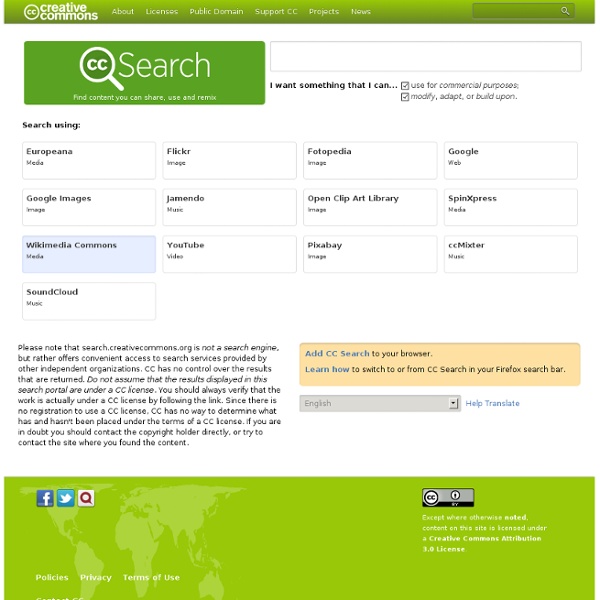



manystuff.org — Graphic Design daily selection Creative Commons Many Flickr users have chosen to offer their work under a Creative Commons license, and you can browse or search through content under each type of license. Here are some recently added bits and pieces: Attribution (CC BY 2.0) » 95407355 photos (See more) Attribution-NoDerivs (CC BY-ND 2.0) » 25257163 photos (See more) Attribution-NonCommercial-NoDerivs (CC BY-NC-ND 2.0) » 118423716 photos (See more) Attribution-NonCommercial (CC BY-NC 2.0) » 64576491 photos (See more) Attribution-NonCommercial-ShareAlike (CC BY-NC-SA 2.0) » 135529936 photos (See more) Attribution-ShareAlike (CC BY-SA 2.0) » 50066962 photos (See more) Public Domain Dedication (CC0) » 4962727 photos (See more) Public Domain Mark » 14526235 photos (See more) "Creative Commons is a non-profit that offers an alternative to full copyright." creativecommons.org Briefly... Attribution means: You let others copy, distribute, display, and perform your copyrighted work - and derivative works based upon it - but only if they give you credit.
Clipartsalbum -Gratis bilder Classeur : PUBLIC DOMAIN IMAGES Siruca Pictograms™, the first Open Source project of Fabrizio Schiavi I’d love to design a lot of new picts for my Siruca Pictograms™ but I can’t find the time, so I asked collaboration to some others icon designers. You can participate to the grow of this project if you like. I’ll publish it just below the text in this page with your name and a link to your site. Don’t worry if you don’t know any font editor, you can send me a Freehand, Illustrator or any vectorial file with your design and I’ll fix it. Authors Guidelines Siruca Pictograms™ is designed to works with Siruca™ font. font with rounded terminations, and this characteristic must be keeped. To simplify my work, please, draw your pictograms as path with trace —in the example on the left: I need the blu path. Have a good trip!
- Teach Students About Creative Commons: 15+ Resources 0 Comments March 9, 2014 By: Shelly Terrell Mar 9 Written by: 3/9/2014 3:03 PM ShareThis Included in the Digital Tips Advent Calendar and part of the Effective Technology Integration category “Nothing is original. Your students will often use images, music, and content created by other individuals. Students can learn about Creative Commons licenses by watching this slideshow explaining Creative Commons. Sites for Creative Common Images Flickr- Go to the Flickr Advanced Search page. Sites for Creative Common Sound Files & Music Challenge: Teach your students about Creative Commons. cross posted at teacherrebootcamp.com Shelly Terrell is an education consultant, technology trainer, and author. Alert to All Users of the Disqus commenting system: Because of a recent global security issue, the Disqus website recommends that all users change their Disqus passwords.
The Educator’s Guide to Copyright, Fair Use, and Creative Commons Lately, we’ve been hearing more and more about digital copyrights and fair use in the news and online – particularly with the whole SOPA/PIPA uproar that recently swept the web. Also, we on the Edublogs support team have been getting more and more complaints and official requests to remove copyrighted content that users have placed on blogs. The legal jargon with respect to digital copyrights can be confusing – especially since different countries have their own laws and regulations. With this post, we hope to dispel a few myths and pull together a complete list of resources for teachers and students to use when blogging and working with content online. Rule #1: You Can’t Use Everything You Find On the Web Dexter the cat hates those that steal his photos… This may seem obvious, but judging by the notices we have received, many teachers (and especially students) are under the impression that if it is on the web, then it is up for grabs. Rule #2: There Are Resources You CAN Use Images Videos
Sök resurser med Creative Commons-licens På den här sidan presenteras ett litet urval av söktjänster och samlingar med Creative Commons-märkta resurser. Det kan till exempel handla om bilder, filmer och musik som genom sin Creative Commons-licens tillåter att verket sprids också på internet. Via CC Search får du möjlighet att söka samtidigt i en rad tjänster/sökmotorer som samlar Creative Commons-licensierat material, till exempel Europeana och Flickr. Du väljer själv, innan sökning, om du vill söka i en, flera eller samtliga tjänster. CC Search Tips: Tänk på att du får fler träffar om du söker på engelska eftersom flera av arkiven är engelskspråkiga och märkta på engelska. Om du är osäker på hur licenserna fungerar kan du läsa mer här: Creative Commons i skolan Sök i Historiska museets samlingar Den här tjänsten ger tillgång till digitaliserade föremål ur Historiska museets samlingar. Platsr - Riksantikvariets webbplats för berättelser och minnen Bilder på miljöer och transport från förr till nu Spårvägsmuseet på Flickr
Copyright Advice for Teachers (What is Fair Use?) : Teach Digital Copyright is a difficult concept for teachers to grasp as a result of the grey areas associated with its relationship with education, even I don’t completely understand it. Ignorance is bliss! Perhaps if you secretly know you are in breech of copyright then it might be advisable to stop reading this article now! This advice is not needed if you have some understanding of the function of Creative Commons and media in the public domain. Most of us know that once a piece of work has been created it is immediately protected by Copyright. Other works can also be in the Public Domain if the copyright owner surrenders their right to the material, which is the general concept of Creative Commons, but again this often comes with conditions that students should be made aware of. Now, lets investigate the grey area of education purposes. If the material is being used for teaching, criticism, commentary, reporting or research then it would be considered fair use. US Copyright Law US Fair Use Advice